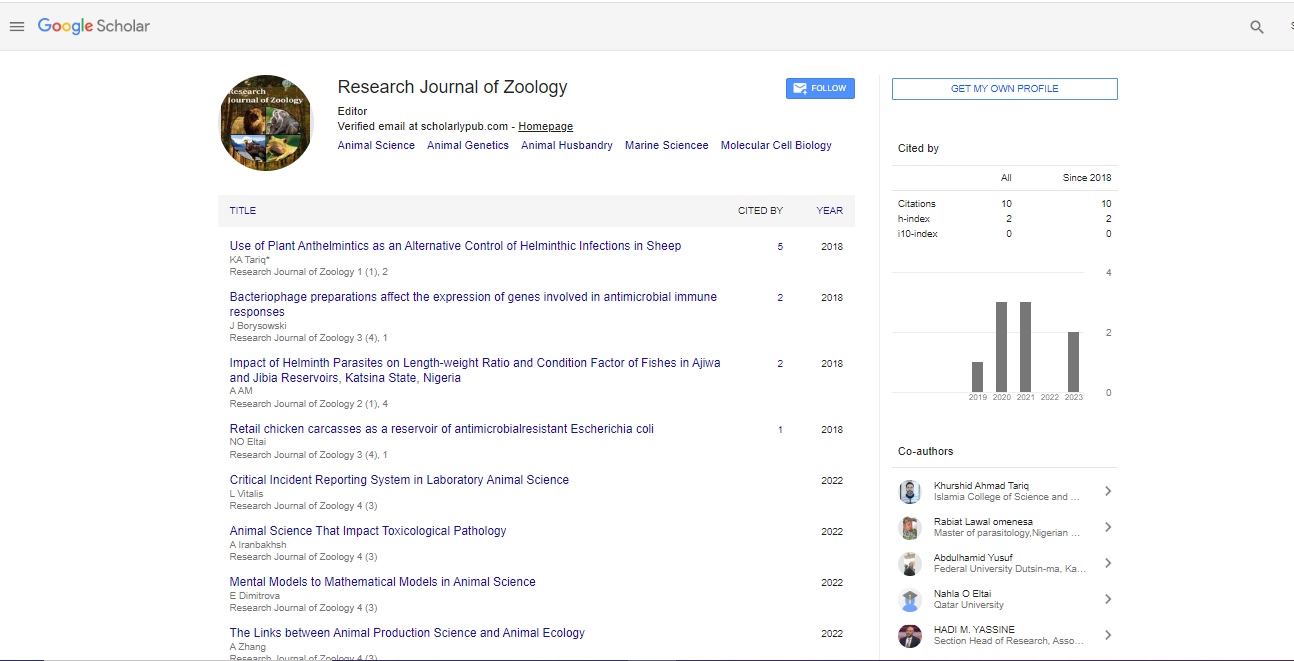Perspective, Res J Zool Vol: 5 Issue: 1
Asexual Reproduction in Multicellular Organisms: Advantages and Disadvantages
Solivia Ames*
1Department of Zoology, The University of British Columbia, Vancouver, Canada
*Corresponding Author: Solivia Ames Department of Zoology, The University of British Columbia, Vancouver, Canada E-mail: soliviaames@gmail.com
Received date: 20-Feb-2023, Manuscript No. RJZ-23-93771; Editor assigned date: 22-Feb-2023, PreQC No. RJZ-23-93771 (PQ); Reviewed date: 09-Mar-2023, QC No RJZ-23-93771; Revised date: 16-Mar-2023, Manuscript No. RJZ-23-93771(R); Published date: 23-Mar-2023, DOI: 10.4172/Rjz.1000073.
Citation: Ames S (2023) Asexual Reproduction in Multicellular Organisms: Advantages and Disadvantages. Res J Zool 5:1.
Description
Asexual reproduction is a type of reproduction that does not involve the fusion of gametes, and is therefore independent of sexual interaction. In multicellular organisms, asexual reproduction can occur through various mechanisms, including budding, fragmentation, and parthenogenesis. While asexual reproduction has several advantages, such as the ability to rapidly produce offspring and maintain favorable traits, it also has several disadvantages, such as the lack of genetic diversity and increased susceptibility to environmental stressors.
Types of Asexual Reproduction
There are several different types of asexual reproduction, each with its own unique mechanisms and advantages. Some of the most common types of asexual reproduction include below.
Budding: In budding, a new individual develops as an outgrowth or bud from the parent organism. The bud may remain attached to the parent organism or may detach and develop into an independent organism.
Fragmentation: In fragmentation, the parent organism breaks into two or more pieces, each of which can develop into a new individual. This process is common in some species of plants and invertebrates, such as sea stars.
Parthenogenesis: In parthenogenesis, an egg develops into an embryo without being fertilized by a sperm. This process is common in some species of reptiles, amphibians, and insects.
Advantages of Asexual Reproduction
One of the main advantages of asexual reproduction is the ability to rapidly produce offspring without the need for sexual interaction. This can be especially beneficial in environments where resources are limited or unpredictable, as asexual reproduction allows organisms to quickly increase their population size and adapt to changing conditions. Asexual reproduction also allows organisms to maintain favorable traits, such as resistance to disease or tolerance to environmental stressors, by passing on exact copies of their genetic material to their offspring.
Disadvantages of asexual reproduction: While asexual reproduction has several advantages, it also has several disadvantages. One of the main disadvantages is the lack of genetic diversity, which can make populations more susceptible to environmental stressors and less able to adapt to changing conditions. Additionally, asexual reproduction can lead to the accumulation of harmful mutations, as there is no mechanism for removing deleterious alleles from the population.
Applications of asexual reproduction: Asexual reproduction has several applications in both research and practical settings asexual reproduction is commonly used to produce genetically identical organisms for studying the effects of genetic and environmental factors on development and behavior. In practical settings, asexual reproduction is used to produce large quantities of desirable organisms, such as crops or animals, in a short period of time. Plants can be cut, grafted, or layered to create artificial vegetative growth. A plant cutting is joined to the stem of another plant that is rooted in the earth using the grafting technique. The plant stem is bent on the ground and covered with dirt when layering. Cutting involves taking a piece of the plant with a stalk or leaf and planting it in the ground. Humans cannot physically reproduce. In some animals, females can bear children without the help of a male. One type of sexual reproduction called parthenogenesis involves females laying unfertilized embryos that become clones.
 Spanish
Spanish  Chinese
Chinese  Russian
Russian  German
German  French
French  Japanese
Japanese  Portuguese
Portuguese  Hindi
Hindi 
